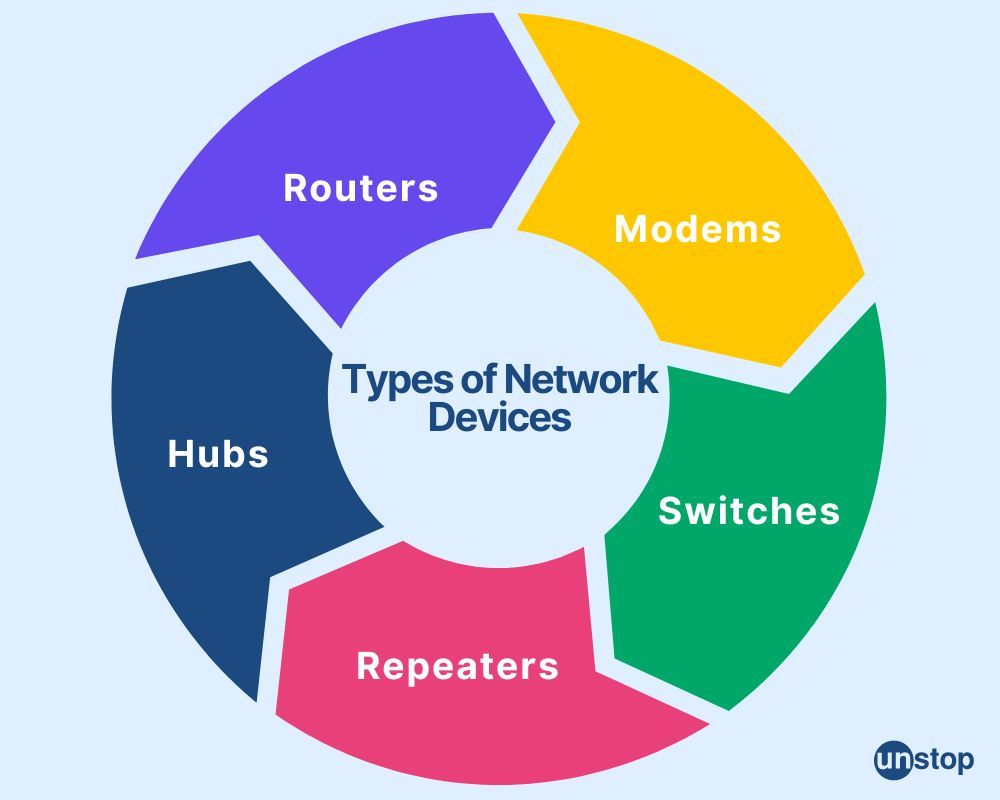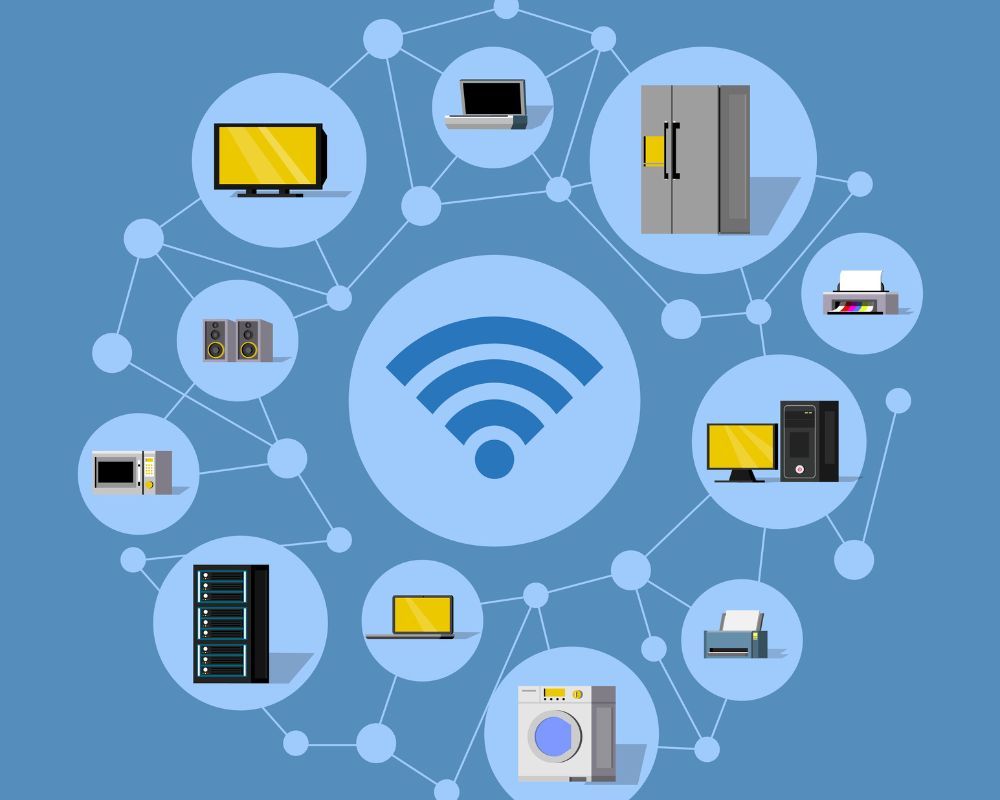- What Are Network Devices
- Overview Of Network Devices
- Types Of Network Devices
- Routers As A Network Device
- Modem As A Network Device
- Switches & Network Segmentation
- Network Security Appliances
- Wireless Devices & Connectivity
- Network Device Configuration & Management
- Troubleshooting Common Network Device Issues
- Future Trends In Network Device Technology
- Frequently Asked Questions (FAQs)
- Master Your Skills: Quiz Time!
Network Devices | Overview, Types, Functions & Network Security

In the realm of technology, network devices ensure seamless connectivity and communication. These essential components, ranging from routers to switches and beyond, form the backbone of modern networks.
Understanding their functions, capabilities, and configurations is paramount for efficient network management.
What Are Network Devices
Network devices are essential components in building and maintaining a functional network infrastructure in computer networking. These devices play distinct roles, contributing to the smooth operation of networks.
Overview Of Network Devices
Let us study the overview of network devices in computers:
Role In Networking
Network devices are essential hardware components that facilitate communication and data transfer among computers and other devices within a network. They are the backbone of any network infrastructure, enabling seamless connectivity and information exchange. These devices operate collectively to ensure effective communication across networks.
For example, when a user sends an email or accesses a website, data packets travel through various network devices before reaching their destination. Each device processes these packets based on its unique function, ultimately contributing to successful data transmission.
With these network devices working harmoniously together, efficient networking is possible.
Concept Of Network Device
Understanding network devices' roles and functionality is imperative for troubleshooting issues and optimizing network performance. By grasping how each device operates within a network ecosystem, IT professionals can identify potential bottlenecks or points of failure more efficiently.
For example, if users experience slow internet speeds despite having high-speed connectivity from their Internet Service Provider (ISP), knowledge about routers can help diagnose whether the issue lies with internal networking equipment rather than external factors.
Types Of Network Devices
Let us briefly study some of the notable types of network devices in computer networking:

Routers
Forwarding data packets between computer networks is carried out with the help of routers. It acts as a junction point where multiple networks connect, allowing devices within those networks to communicate.
Modems
Modems are devices that modulate and demodulate digital data for transmission over analog communication lines. Modems take digital signals from computers, convert them to analog signals for transmission, and then change them back to digital signals for the receiving computer.
Switches
Switches are networking devices that connect multiple devices on a local area network (LAN). Switches improve network efficiency by reducing collisions and enabling simultaneous communication between devices.
Hubs
Hubs link devices in a network, enabling communication. They are now seen as less advanced than switches for networking.
Access Points
Access points serve as a connection point between wired networks and wireless devices, enabling devices to access the network wirelessly without the need for physical cables. They emit a Wi-Fi signal that allows devices to connect to the network seamlessly.
Network Interface Cards (NICs)
Network Interface Cards (NICs) are hardware devices that allow computers to connect to a network by providing a physical data-transmission interface. They enable communication between devices within a network by converting data into a format that can be transmitted over the network.
Repeaters
As network devices, repeaters renew and boost signals to expand a network's coverage without compromising data integrity through distortion or loss.
Bridges
Bridges are network devices that connect two different network segments to control traffic flow and improve network performance by filtering and forwarding data packets based on Media Access Control (MAC) addresses.
Wireless Adapters
Wireless adapters allow electronic devices to connect to a wireless network, enabling internet access without needing physical cables. They come in various forms, such as USB dongles or PCI cards, and are essential for devices like laptops and desktop computers to access Wi-Fi networks.
Routers As A Network Device
Routers, as network devices, play an indispensable role in transferring data packets between different networks. Routing protocols are employed by network devices to assess destination addresses and identify the optimal route for transmitting data efficiently.
Switches link numerous devices in a local area network (LAN), whereas routers guide traffic across distinct networks.
For example, when you send an email from your computer to a friend across the country, routers ensure that the data travels through various network points before reaching its final destination.
Routers are like traffic directors on the internet highway, guiding information to their intended location by choosing the best route based on network conditions and congestion levels.
They help prevent data congestion by efficiently distributing information across LAN and Wide Area Networks (WAN). This process ensures that your online activities run smoothly without delays or interruptions.
Modem As A Network Device
A modem is an important device in a network as it links a computer or router to the internet using either a telephone line or a cable. It modulates digital data from a computer into an analog signal for transmission over the phone line and demodulates incoming analog signals back into digital data.
A modem links computers' digital realm and telephone lines' analog world, enabling smooth information exchange across networks. Technological progress has led to modems supporting quicker data transfer rates and more effective communication protocols, making them vital elements of contemporary network setups.
Switches & Network Segmentation
Switches are important in network devices because they help divide the network into smaller parts, known as Virtual Local Area Networks (VLANs). This separation created by switches improves security within a big network. By organizing the network into various VLANs, switches keep data safe within their assigned group.
For instance, imagine a school's network where the administration staff needs access to sensitive information like student records while students should only have access to educational resources.
Switches play a crucial role in networks by directing data packets to the correct device within a specific VLAN, thereby lowering the chances of unauthorized access to confidential data or cyber-attacks.
In essence, switches act as gatekeepers that carefully direct traffic flow within each segmented area of the network.
Network Security Appliances
Let us study the importance of network security appliances:
Firewalls
Firewalls create a protective barrier, managing incoming and outgoing network traffic to prevent unauthorized access. They act as gatekeepers, filtering data based on predefined security rules.

Firewalls are comparable to security checkpoints at the entrance of a building; they inspect all individuals entering or exiting for any suspicious activity.
Similarly, firewalls examine data packets trying to enter or leave a network, ensuring only legitimate traffic passes through while blocking potential threats.
Intrusion Detection Systems
Intrusion Detection Systems (IDS) constantly monitor network traffic for unusual patterns that might indicate malicious activities. Think of IDS as vigilant security guards patrolling an area, looking out for any signs of danger.
When IDS detect suspicious behavior or potential security breaches, they raise alerts to prompt immediate action.
For example, if someone tries to gain unauthorized access to sensitive information within a network, the IDS will quickly identify this abnormal activity and notify administrators about the breach.
This proactive approach helps mitigate risks before they escalate into significant cybersecurity incidents.
Wireless Devices & Connectivity
Wireless technology offers several advantages that enhance user experience and productivity within a network. The absence of physical connections allows for flexibility in device placement, enabling users to position their equipment wherever needed without being limited by cable lengths or locations.
This flexibility is particularly beneficial when wired connections are impractical or inconvenient. The mobility afforded by wireless devices is another significant advantage.
For example, individuals working in an office setting can easily transition between meeting rooms or workstations without losing connection to critical resources.
Network Device Configuration & Management
Network devices require proper configuration for optimal performance and security. This ensures that they function efficiently and securely within the network. Devices may experience connectivity issues without correct settings or become vulnerable to cyber threats.
Configuring network devices involves setting up parameters such as internet protocol (IP) addresses, routing tables, security settings, and more.
For instance, assigning unique IP addresses to each device helps identify them on the network. Routing tables determine how data packets are forwarded between devices, ensuring efficient communication.
Management Tools & Protocols
Network administrators utilize specialized management tools and protocols to remotely configure, monitor, and troubleshoot network devices.
Tools like Simple Network Management Protocol (SNMP) allow administrators to gather information about device status, performance metrics, and potential issues across the network.
Troubleshooting Common Network Device Issues
Network devices can encounter connectivity problems that disrupt communication. Issues like loose cables or faulty network ports can lead to connectivity disruptions. Troubleshooting involves checking all physical connections and ensuring they are secure and properly connected.
For instance, verifying the Ethernet cable connection between the computer and router is crucial if a computer cannot connect to the internet.
Slow Performance
Slow performance in network devices can be frustrating for users and impact productivity. This issue may result from bandwidth congestion, outdated firmware, or excessive network traffic. Troubleshooting slow performance entails analyzing network logs to identify bottlenecks or irregularities affecting device speed.
For example, if multiple users complain about slow internet speeds at specific times of the day, it could indicate bandwidth congestion during peak hours.
Configuration Errors
Configuration errors on network devices can lead to operational inefficiencies and security vulnerabilities within the system architecture. Network device configuration mistakes might occur due to human error while setting up routers, switches, or firewalls.
Troubleshooting configuration errors requires verifying settings against established best practices and correcting any discrepancies found.
For instance, a misconfigured firewall rule might prevent specific applications from accessing the internet correctly.
Future Trends In Network Device Technology
Let us study the future trends in network device technology:
Software-Defined Networking (SDN)
Software-defined networking (SDN) is revolutionizing network device technology. It offers centralized control and programmability, streamlining operations, enhancing flexibility, and improving scalability.
With SDN, network administrators can manage multiple devices from a single interface, simplifying configuration changes and reducing manual errors. This advancement allows for dynamic traffic management, ensuring optimal performance across the network.
For example, during peak hours when more bandwidth is required, SDN enables automatic adjustments to ensure seamless connectivity without human intervention.
Internet Of Things (IoT) Integration
Integrating Internet of Things (IoT) devices into networks marks another significant trend in the evolution of network device technology. The increasing number of connected IoT devices poses challenges regarding network connectivity management and security protocols.

As these devices communicate with each other and external systems over the internet, robust measures are essential to safeguard data transmissions.
Network administrators must implement stringent access controls and encryption mechanisms to protect sensitive information transmitted by interconnected IoT gadgets within the network environment.
Conclusion
Different network devices are crucial for modern networks to operate smoothly. Knowing the different types, functions, and setups of these devices is important for effective network operations and robust security measures.
Routers, switches, security appliances, and wireless devices collectively form the backbone of interconnected systems, facilitating communication and data exchange across vast networks.
Frequently Asked Questions (FAQs)
1. What are network devices?
Network devices are hardware components used to connect computers, servers, and other devices to form a network. These include routers, switches, firewalls, access points, and more.
2. How do routers contribute to networking?
Routers are crucial in directing data packets across networks by determining the best path for information to travel. They help facilitate communication between different networks.
3. Why is network segmentation important?
Network segmentation using switches helps improve security by dividing the network into smaller parts. This limits the impact of security breaches or issues in one segment on the entire network.
4. What is the significance of network security appliances?
Network security appliances protect against cyber threats like malware, unauthorized access attempts, and data breaches. They help safeguard sensitive information and ensure secure network operations.
5. How do wireless devices enhance connectivity?
Wireless devices enable users to connect to networks without physical cables, offering flexibility and convenience. They support mobility within an organization or home environment while maintaining reliable connectivity.
Master Your Skills: Quiz Time!
Suggested reads:
- Tree Topology | Advantages & Disadvantages In Computer Network
- Ring Topology | Basic Concept And Its Advantages & Disadvantages
- Mesh Topology | Characteristics, Benefits And Types Explained
- Star Topology In Computer Network | Working Mechanism Explained
- Difference Between Break And Continue Statements In C (+Explanation)
Instinctively, I fall for nature, music, humor, reading, writing, listening, traveling, observing, learning, unlearning, friendship, exercise, etc., all these from the cradle to the grave- that's ME! It's my irrefutable belief in the uniqueness of all. I'll vehemently defend your right to be your best while I expect the same from you!
Login to continue reading
And access exclusive content, personalized recommendations, and career-boosting opportunities.
Subscribe
to our newsletter
















Comments
Add comment